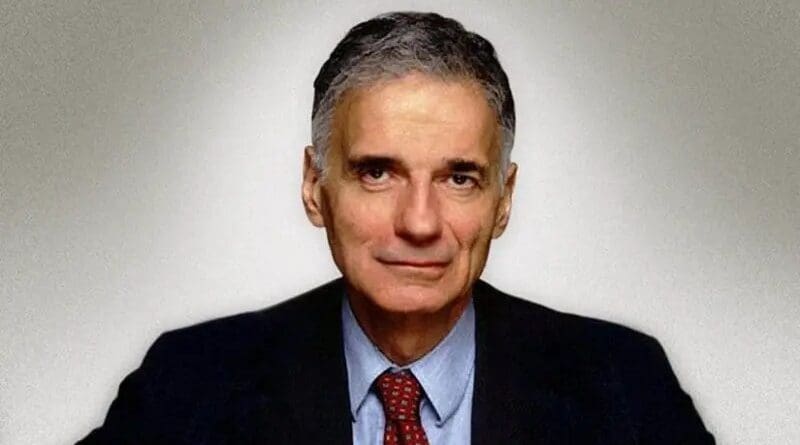Ralph Nader: TSA Is Delivering Naked Insecurity – OpEd
By Ralph Nader
o airline passengers: Get ready for naked insecurity.
To the Department of Homeland Security: If you thought this week was bad, brace yourself for a tsunami of protests in the days ahead. This month Homeland Security has implemented a new rule calling for extremely invasive pat-downs of commercial airline passengers who decline to use full-body, “backscatter technology” scanners that use low-level X-rays. Pregnant women, parents with young children, adherents of religions, amputees and people with wireless insulin pumps or embedded medical devices are increasingly saying, “No thanks.” They do not believe they should be exposed to technology that could pose risks, may malfunction, and certainly invades their privacy. So Homeland Security has doubled its trouble by turning to the invasive pat-downs. What the department should do is reconsider its use of these scanners, but after reading Homeland Security Secretary Janet Napolitano’s full-throated defense of the technology and procedures on this page this past Monday, I’m not hopeful.
Questions, and lawsuits
The technology has already been challenged by recognized academic specialists on both safety and efficacy grounds. After six months of testing at four major airports, Italy is likely to drop these scanners, finding them ineffective and slow. The European Commission has also raised “several serious fundamental rights and health concerns” and recommends less-intrusive alternatives.
Back in the USA, the legal volleys have begun. Two weeks ago, the Electronic Privacy Information Center, a public interest research center, filed a lawsuit in federal court against the Department of Homeland Security. The suit alleges violations of the Fourth Amendment, the Privacy Act, the Religious Freedom Restoration Act, the Video Voyeurism Prevention Act and the Administrative Procedure Act (which calls for public hearings).
Immersed in its own bureaucratic bubble of secrecy and inaccessibility, Homeland Security cites “national security” as justifying its unresponsiveness to critics. Napolitano wrote in USA TODAY that our security depends on being “more creative” in adapting to evolving threats. Indiscriminate pat-downs are anything but creative. Yet the department listens to commercial lobbyists pushing scanner sales, including former Homeland Security secretary Michael Chertoff.
Earlier corporate pitchmen sold the department on the notorious puffer machines. This $36 million boondoggle forced Homeland Security to remove these failed screeners from airports last year at considerable embarrassment and expense.
The department says full-body imaging is aimed at prevention. If so, why do passengers on the 15,000 U.S. registered business aircraft escape screening? Why, nine years after 9/11, is the department still way behind in the screening of air freight on passenger and cargo planes, where far more dangerous packages can bring down a plane?
For more than 40 years, public interest groups have been advocating for airline safety. After the numerous hijackings to Cuba in the late 1960s, we and air security experts pressed the Federal Aviation Administration to require airlines to strengthen cockpit doors and latches — to no avail. It took the 9/11 attacks before the FAA required the airlines to retrofit. Stonewalling, long a bureaucratic obsession in these areas, must end. A good start would be addressing these uncertainties:
Radiation: Homeland Security should respond when physics professor Peter Rez of Arizona State University calculates the radiation dose to be 10 times higher than the department is asserting. Or when David J. Brenner of Columbia University’s Center for Radiological Research says that using these scanners — with up to 1 billion whole-body X-ray scans per year in the U.S. — “may profoundly change the potential public health consequences to the population.”
Malfunctions. John Sedat, one of four scientists at the University of California-San Francisco who is questioning the department’s technical assertions, said these machines could stall, giving passengers “severe burns if not worse.” He points out that “software fails often.”
And then there are the emerging first-person experiences of travelers. The rough pat-downs experienced by New York Times business travel columnist Joe Sharkey and Atlantic author-writer Jeffrey Goldberg are generating more such passenger complaints. So much for the friendly skies.
Better paths to security
Changing this policy, or even backtracking, doesn’t mean we’d suddenly be flying on a wing and a prayer. In fact, better use of available intelligence alone would have stopped last year’s Christmas underwear bomber from flying to the USA. Indiscriminate and inefficient dragnet-type security checks of whole populations, if anything, make us less safe by focusing on the wrong things.
One area in which I agree with Secretary Napolitano: Cooperation of the public is key to averting attacks. So it seems counterintuitive to antagonize the very people you’re counting on to help you get the bad guys. Meantime, Homeland Security is turning TSA agents, who are at some radiation risk themselves, into government gropers without either suspicion or probable cause. People want security, but they do not like irrational, ineffective, invasive and hazardous over-reach.
DHS continually refuses to hold thorough public hearings or to answer reasoned technical, economic and other policy challenges to its practices. Congress must assert its authority to end what one TSA risk analyst has called its “culture of stupidity.”

